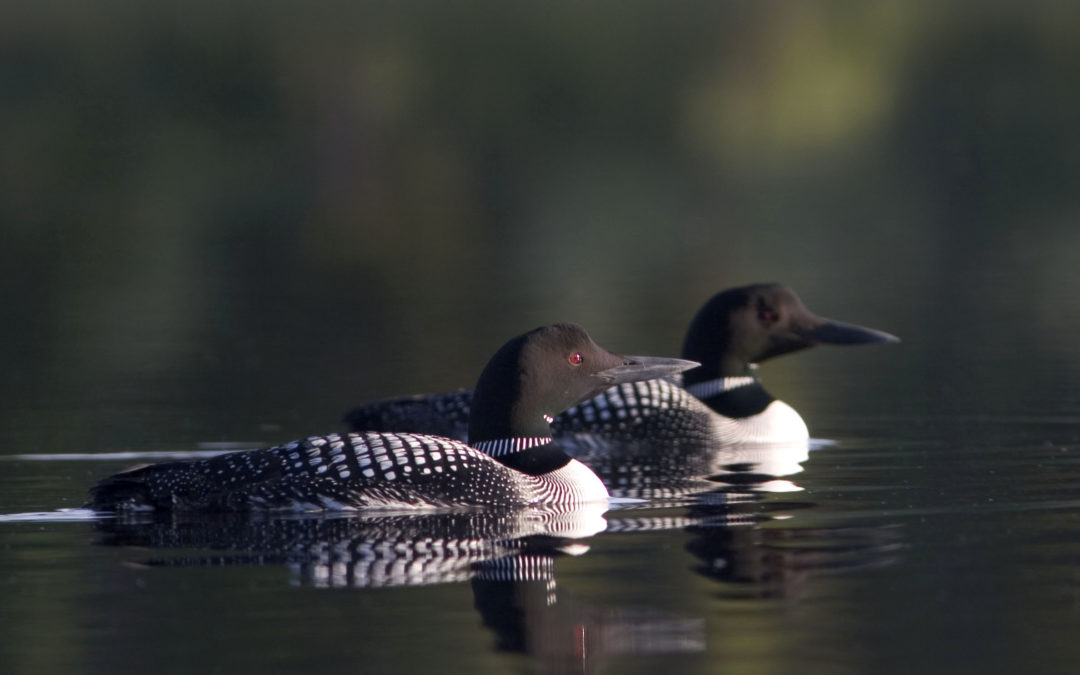
by jhwildlife | Sep 15, 2017 | Blog, Nature Mapping Jackson Hole
by Susan Patla, Non-game biologist for WGFD and NMJH Science Advisory Committee member
The call of a loon echoing across a still mountain lake is a sound that embodies the essence of wilderness. Biodiversity Research Institute (BRI), in partnership with Yellowstone and Grand Teton National Parks and Wyoming Game & Fish Department (WGFD), recently completed a fifth field season to monitor and study common loons in Wyoming. This project has been funded through a generous grant by the Ricketts Conservation Fund to determine the conservation status of loons in Wyoming and four other states. The loon is the rarest nesting bird species in Wyoming and a designated species of conservation concern. The Wyoming population is also the most southern nesting group in North America and isolated from the nearest neighboring population in Montana by over 200 miles. While migrating loons can be seen across the state both in spring and fall, breeding pairs currently occur only in the northwest part of the state.
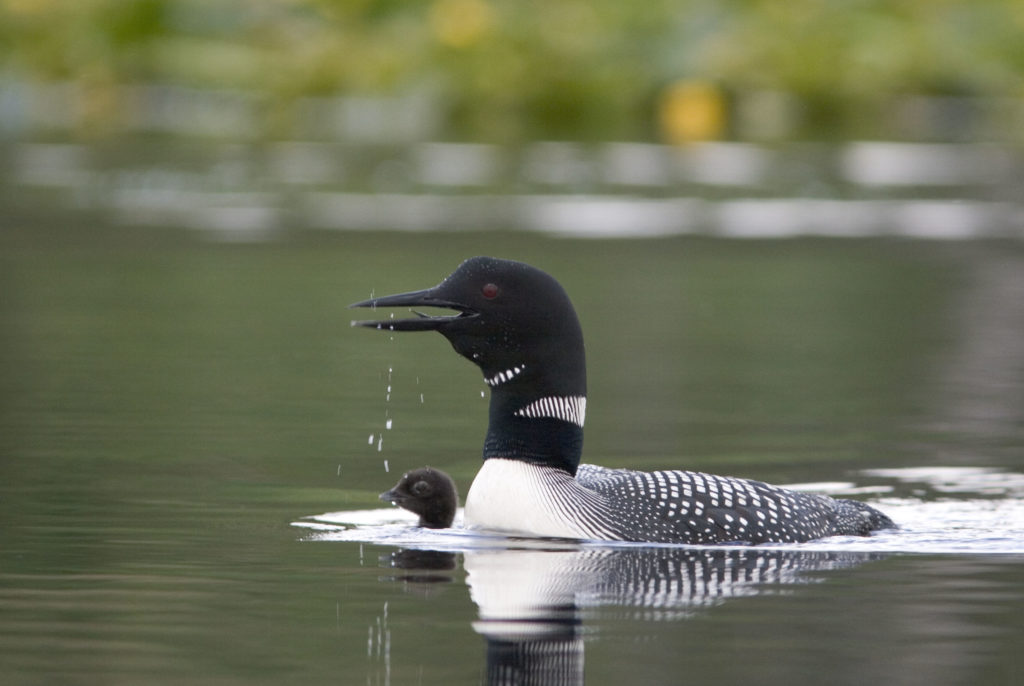
Since 1987, Yellowstone NP and WGFD have been monitoring the presence of loon pairs and fledged chicks. In 2013, BRI expanded on this effort through increased monitoring of pairs during the nesting season and the capture and banding of adult loons. In 2017, there were 21 territorial pairs documented (15 of which were in Yellowstone), and at least 12 of these attempted to nest. Eight pairs successfully hatched a total of ten chicks and all survived to fledging. Seven unpaired adults and one immature loon were also seen. One territorial female adult was captured and banded, and young were banded at two additional sites. Results from blood and feather samples for mercury and genetic analyses will be available later. BRI also deployed nest rafts at four sites and worked with agencies to implement management measures to protect nesting pairs.
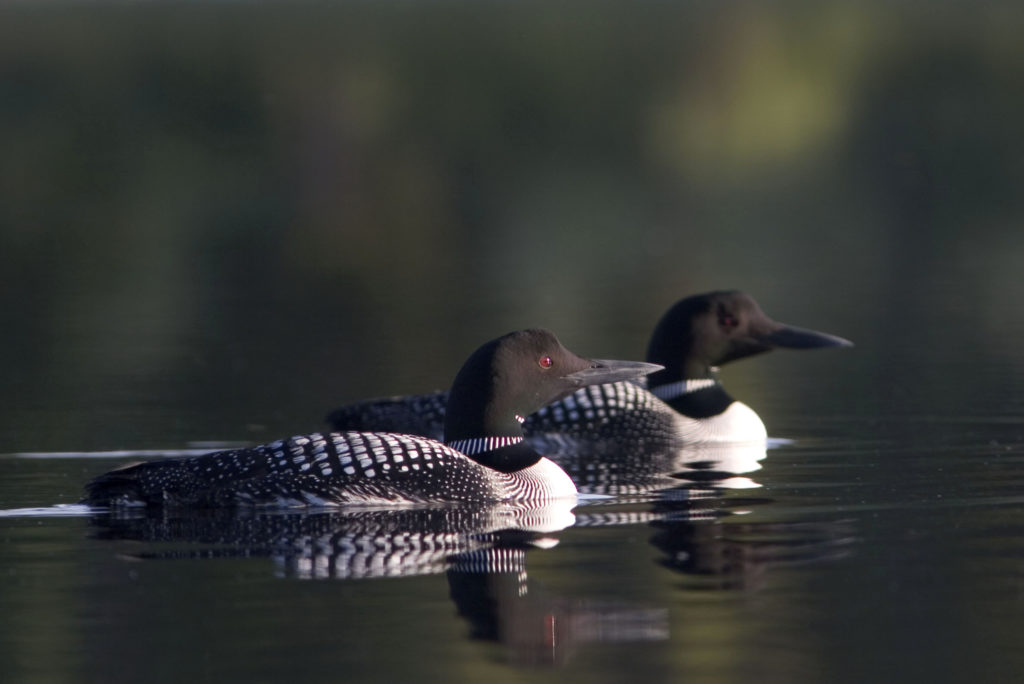
Compared to 2016, Wyoming had one fewer territorial pair and productivity was slightly lower than previous years. Nest success was affected this year by the above average snowfall, and late ice-out on many of the nesting lakes which were still frozen in early June. Rapid runoff resulted in flooding at a few sites also. Surveys of many backcountry lakes were also restricted in the early season due to lingering deep snow conditions. Productivity, however, over the study period has been above the 0.48 chicks surviving per territorial pair needed for population stability. Loons have been seen in recent years in the Wind River Range although no nesting pairs have been found. In the future, translocation of chicks may be considered to help expand the nesting population in Wyoming. Major threats to this population include human disturbance of nest sites, drought, and water quality. Mercury contamination, which has been a problem in New England loons, does not appear to be affecting Wyoming loons. All documentation of loons by Nature Mappers is greatly appreciated by BRI and the partner agencies to help in understanding the distribution and movements of this magnificent bird.
Click the image to enlarge and back button to get back to post. Photos by Mark Gocke, WGFD.
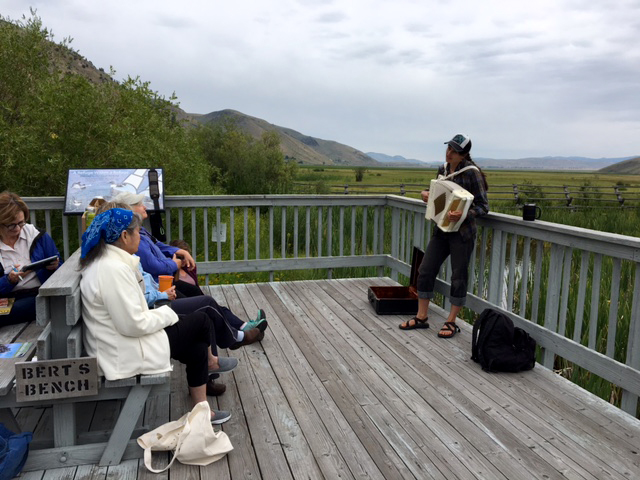
by jhwildlife | Jul 26, 2017 | Blog, Nature Mapping Jackson Hole
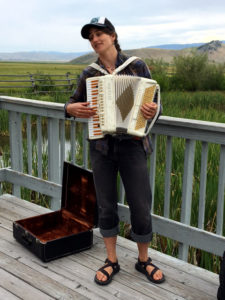 Very recently an exclusive opportunity was made available to all certified Nature Mappers and 13 of them joined JHWF and scientist Anya Tyson on July 25 for a discussion on the Clark’s Nutcracker — a clever bird with a big conservation importance.
Very recently an exclusive opportunity was made available to all certified Nature Mappers and 13 of them joined JHWF and scientist Anya Tyson on July 25 for a discussion on the Clark’s Nutcracker — a clever bird with a big conservation importance.
As the primary seed disperser of the whitebark pine, Clark’s Nutcrackers plays a critical role in our ecosystem (whitebark pine nuts are a key, high-energy food source for grizzly bears). Severe mountain pine beetle outbreaks and an introduced fungus — white pine blister rust — have caused the whitebark pine to decline across much of the northern Rockies. As forest managers attempt to restore and protect these alpine zones unique to places like Jackson Hole, they need more data on how nutcrackers are using our high-elevation forests, which can be challenging to obtain given the difficulty in sending larger numbers of researchers into the field, especially given the backcountry terrain.
For our private scoop on the latest news, we gathered at Bert’s Bench in the Murie Family Park and over a fresh brew of coffee, enjoyed an update from Anya about her citizen science work with students to conduct habitat surveys in relation to observations of Clark’s Nutcrackers in the backcountry. Anya also gave us an update on Dr. Taza Schaming’s research that uses Nature Mapping data alongside other datasets to model which habitat features best predict Clark’s Nutcracker presence in mountain landscapes. Her recommendations to land managers will help guide whitebark pine conservation and restoration efforts.
Keep a look out for this clever bird and enter your observations into the Nature Mapping Jackson Hole database under Casual Observations. Alternatively, for those active with Project Backyard be sure to notice and record if Clark’s are visiting your feeders later in the year.
Every data point logged for Clark’s Nutcracker will be useful for Anya’s project work and Dr. Taza Schaming’s research.
Anya would love to hear of any interesting stories related to your Clark’s Nutcracker observations and she encourages you to email her at: anyamtyson@gmail.com. Learn more about the Clark’s Nutcracker Project here.

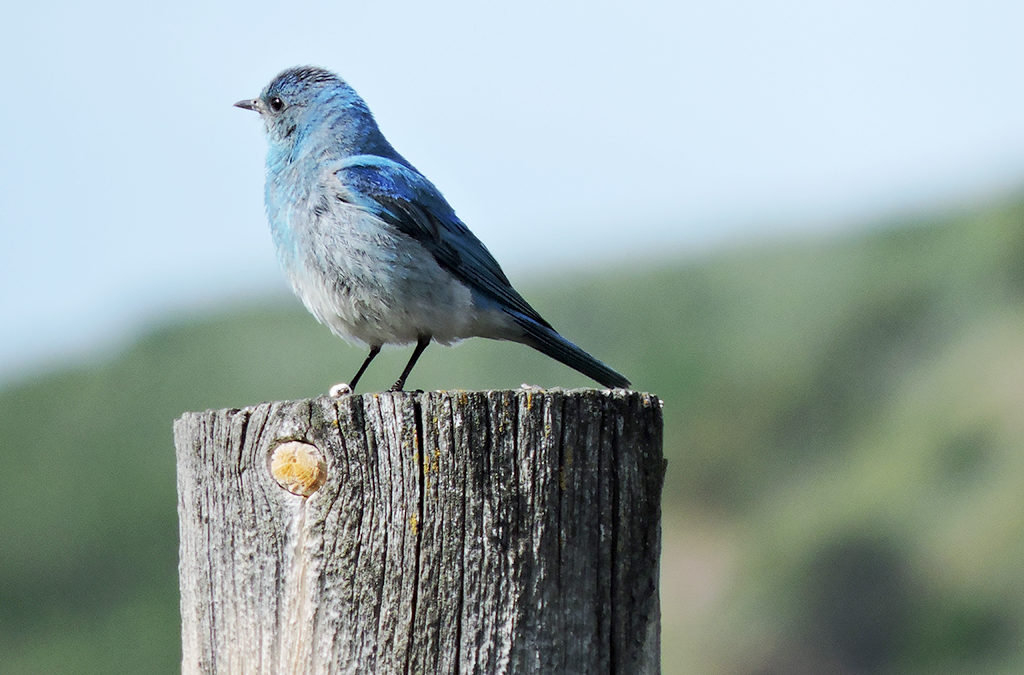
by jhwildlife | Jul 12, 2017 | Blog, Nature Mapping Jackson Hole
As one leaves the town of Jackson and heads north on HWY 89, a trail of nestboxes lines the fencing of the National Elk Refuge. These nestboxes are part of JHWF’s Mountain Bluebird Nestbox Monitoring Project, which is designed to mitigate for extreme habitat loss that has negatively impacted the breeding success of this species. Monitoring work has been conducted for the past 13 years, but this summer we added a new element to the project by hiring bird bander Allison Swan. With help from our volunteers, Allison has banded 98 chicks and 1 female adult since May.
With data collected through banding and the re-sighting of individuals, we will be able to evaluate survival rates of young, dispersal patterns, re-nesting rates, productivity by age, site fidelity, and other measures of population dynamics. This type of information will allow us to understand population status in Jackson Hole and to better inform land management decisions with respect to the Mountain Bluebird.
Almost all chicks born this summer have fledged their nests and now is the time to begin searching for our color-banded birds — 99 in total.
Already several banded birds have been re-sighted through the use of binoculars and spotting scopes. Our first sighting was a juvenile Mountain Bluebird who crossed the highway and was seen in the parking lot of the National Museum of Wildlife Art. Fledglings can fly quite well, but many are still being fed by the adults, which means they will often stay in place long enough to get a good look at colored-bands on their legs.
All Nature Mappers, we need your help re-sighting banded bluebirds! The most important data we need collected is location data and the color band scheme for each bird. Ideally, we would also like to collect additional data on behavior, substrate and plumage.
The color bands are noticeable and folks have been reporting that it is easy to read the colors, especially with use of binoculars. If you do not have binoculars, please stop by the Jackson Hole Wildlife Foundation office and borrow a pair! We have three scopes and two pair of binoculars for volunteers to borrow while conducting observations.
Download our Re-sighting Datasheet here. As you observe and record sightings of this year’s birds note each ones unique color combination. Datasheets should be given to our Associate Director, Kate Gersh at: Kate@jhwildlife.org. We also encourage the sharing of verbal reports by calling our office at: (307) 739-0968.
Thanks for the help!
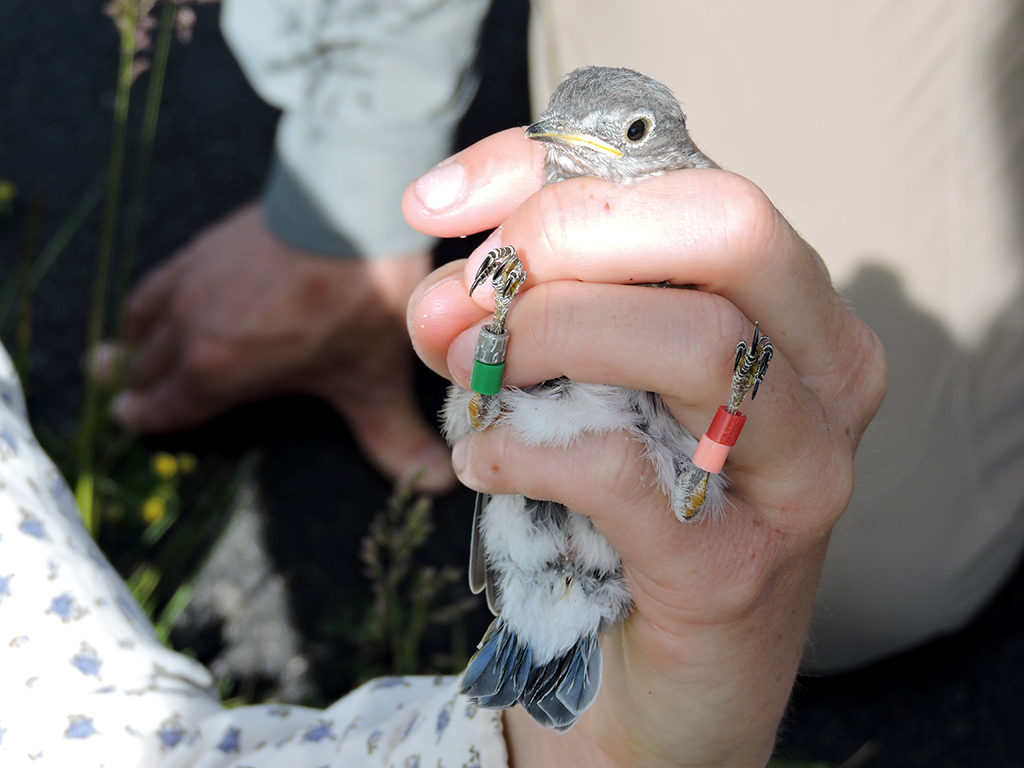
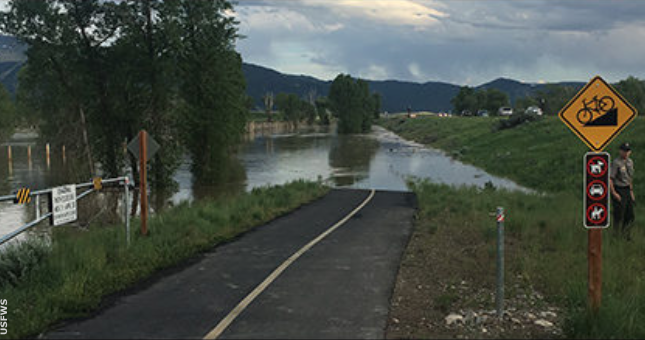
by jhwildlife | Jun 22, 2017 | Blog, Nature Mapping Jackson Hole
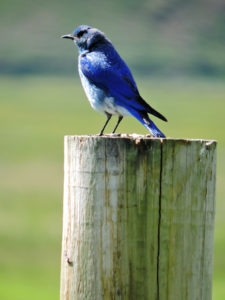 Over the past several weeks, a unique situation was unfolding along our Mountain Bluebird Nestbox Monitoring Trail here in Jackson Hole. Thanks to a serious winter, flooding occurred in our area from fast melting, high altitude snow. Historic flood levels not witnessed in decades. On a Mountain Bluebird trail of 110 nestboxes, several north of town were underwater for weeks, but fortunately those boxes were empty. However, one box — Box #4 — managed to stay just above the flood waters and it held four baby chicks inside. As the Gros Ventre River continued to flow fast and furiously, these hatchlings grew older and days closer to fledging their nest. This posed a great conundrum for the staff of JHWF… .
Over the past several weeks, a unique situation was unfolding along our Mountain Bluebird Nestbox Monitoring Trail here in Jackson Hole. Thanks to a serious winter, flooding occurred in our area from fast melting, high altitude snow. Historic flood levels not witnessed in decades. On a Mountain Bluebird trail of 110 nestboxes, several north of town were underwater for weeks, but fortunately those boxes were empty. However, one box — Box #4 — managed to stay just above the flood waters and it held four baby chicks inside. As the Gros Ventre River continued to flow fast and furiously, these hatchlings grew older and days closer to fledging their nest. This posed a great conundrum for the staff of JHWF… .
If the chicks were to fledge into water they would inevitably die. We wondered if anyone had had success with moving a nestbox with chicks inside? We thought about trying to move the box down 75 yards south to dry land. These hatchlings would still need tending to by parents so our hope would be that disturbance wouldn’t cause them to abandon their chicks if the nestbox was moved to a nearby location. Our other option was to let nature take its course; although that felt a bit tough since we’re accountable for installing an artificial nesting cavity. JHWF’s nestbox monitoring project is supporting breeding success as a mitigation effort for habitat loss throughout the Mountain Bluebirds’ range. With only good intentions in mind, either decision we made, came bearing a level of responsibility. In thinking that we could give the chicks in Box #4 a fighting chance to survive, we set about on a relocation mission.
In recent days flood waters have receded! We’ve taken HUGE sighs of relief because our attempt to move the nestbox was unsuccessful due to tricky conditions navigating through water and muck. Three days ago, one of our volunteers saw two “unbanded” fledglings just south of Box #5. These birds must be from Box #4 because all other chicks on our Trail have been banded as part of the larger research project. An adult with food was also onsite yesterday. We choose to assume that the other two chicks also fledged to dry ground. When they finally fledge the nest, Mountain Bluebird chicks have all their flight feathers and it’s possible for them to fly at least 100 yards to start. Although, it’s well documented that they choose to drop to the ground first and stay there for a while. Somehow these chicks figured out that they needed to get distance on those wings right away. Fly on little bluebirds, fly on!
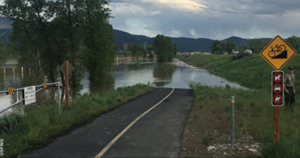
Photo: US Fish & Wildlife Service
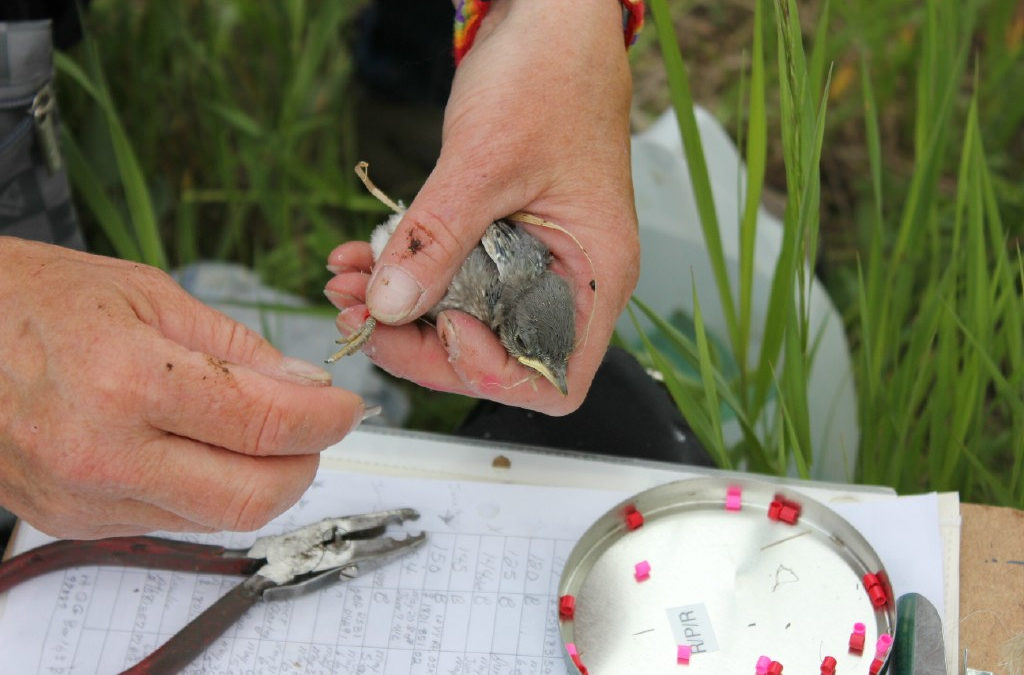
by jhwildlife | Jun 15, 2017 | Blog, Nature Mapping Jackson Hole
Since 2003, Nature Mapping Jackson Hole volunteers have monitored 104 Mountain Bluebird (MOBL) nestboxes along the National Elk Refuge (NER). Over the course of many years the loss of standing aspens, cottonwoods, and other riparian vegetation due to thousands of browsing elk has meant the loss of nesting habitat for cavity-dwelling birds such as, the Mountain Bluebird. Historically, bluebirds depend on nest sites in decaying trees and on nesting cavities excavated by woodpeckers and other bird species. JHWF’s Mountain Bluebird Nestbox Monitoring Project is designed to mitigate for this habitat loss by providing artificial nest cavities to support breeding.
A new addition to the monitoring project this summer, our volunteers will have the opportunity to monitor a total of a 110 nestboxes, and see what happens to the birds after they leave the nestbox by banding nestlings and collecting data on their activity post-fledge. JHWF has secured a Chapter 33 permit from the Wyoming Game & Fish Department for scientific research and hired bird bander Allison Swan (in collaboration with the Teton Raptor Center) to execute the banding program.

WGFD Chapter 33 Permit. Maybe JHWF’s first!
Banding birds provides critical data for demographic studies and the management and conservation of those populations. We know with certainty that habitat loss has played a role in declining populations of Mountain Bluebirds, but we aim to learn if and how other factors have affected this species. Hence, it is important for us to collect data via banding to evaluate survival rates of young, dispersal patterns, renesting rates, productivity by age, and other measures of population dynamics. This type of information will allow us to see how the birds have been faring in Jackson Hole and to ascertain land management options with this species in mind.
NOTE: Banding is completed quickly and does not hurt the birds!
Stay tuned for more news from the field as the summer progresses and baby birds take to the skies!
About Allison Swan:
A Wyoming native, Allison Swan is a graduate of The Evergreen State College with a BA/BS dual degree in ecology and ornithology. She has abundant experience working at Monitoring Avian Productivity and Survivorship (MAPS) stations with students and volunteers, as well as conducting ecological research on focal species. As a student and research fellow, she conducted ecological research on Pacific Wrens throughout the non-breeding and breeding seasons. She has also worked on a number of research projects including, songbird ecology in the rainforests of the Olympic Peninsula, breeding seabirds in Puget Sound, raptor surveys and raven telemetry in sagebrush country. When she’s not banding birds, she enjoys hiking, biking and spending time in the outdoors with her dog, Boulder.
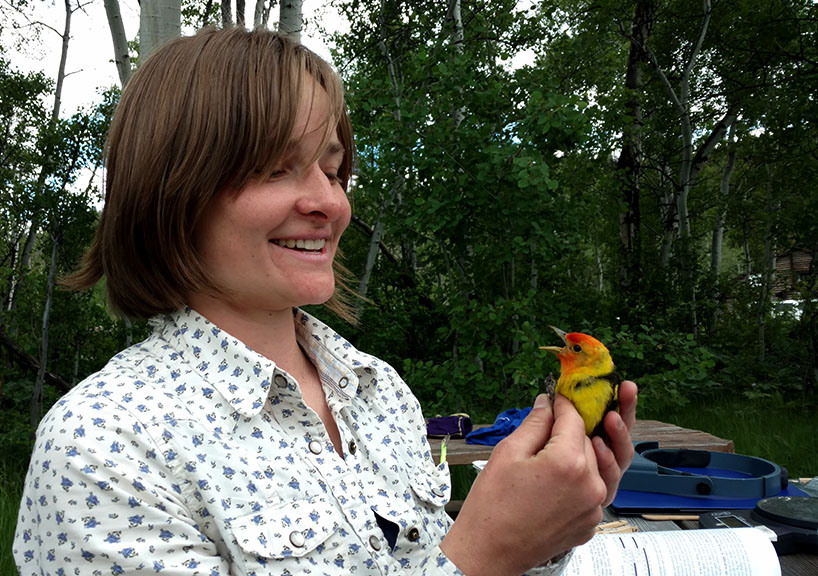
Allison Swan banding a Western Tanager in Jackson Hole – June 15, 2017.
Photo credit for the banding photo on the Blog Page: Ellis Bird Farm

by jhwildlife | Jun 1, 2017 | Blog, Nature Mapping Jackson Hole
 Last month, JHWF’s Executive and Associate Directors attended the biannual meeting of the Citizen Science Association (CSA) in St. Paul, MN. The CSA aims to bring together the expertise of diverse practitioners working in the field of citizen science, to share the breadth of resources and best practices found throughout the field. Only a few years old, CSA’s membership already exceeds 4,000 individuals from over 80 countries. Indeed, there was a welcomed international contingent in attendance at this gathering of “citsci folks” – Brazil, New Zealand, England, Canada, Australia and Kenya, to name a few.
Last month, JHWF’s Executive and Associate Directors attended the biannual meeting of the Citizen Science Association (CSA) in St. Paul, MN. The CSA aims to bring together the expertise of diverse practitioners working in the field of citizen science, to share the breadth of resources and best practices found throughout the field. Only a few years old, CSA’s membership already exceeds 4,000 individuals from over 80 countries. Indeed, there was a welcomed international contingent in attendance at this gathering of “citsci folks” – Brazil, New Zealand, England, Canada, Australia and Kenya, to name a few.
We came home with our heads full of ideas for our very own Nature Mapping Jackson Hole program, which is a super example of citizen science in action. Conversations at the conference covered many critical areas, such as: the need for fostering community amongst citizen science professionals, a sense of creating a mandate around using well-vetted knowledge to make a difference, advancing the role of public citizens in conducting and defining research, and most of all, fostering and strengthening partnerships across the board.
Best of all, we came back from this conference with a reconfirmation of the value and specialness that is Nature Mapping Jackson Hole. Within the past nine years, 435 people have been trained as certified Nature Mappers and have entered 45,345 observations into the program’s central database. All this effort is filling wildlife observation and distribution needs not already covered by state and federal agencies or local research organizations. Furthermore, together we are fostering a community that looks deeper into the meanings of science and citizenship – therefore, realizing that to participate in the building of knowledge about how our world works, can have profound implications for the way we, Jackson Hole, relate to our natural environment and shape its future.
Thank you for getting involved in the experiences of seeing, feeling, and understanding nature in all its amazingness through Nature Mapping Jackson Hole. Keep up the great work, it’s making a difference!
The whole of science, and one is tempted to think the whole of the life of any thinking man, is trying to come to terms with the relationship between yourself and the natural world. Why are you here, and how do you fit in, and what’s it all about?
– Sir David Attenborough



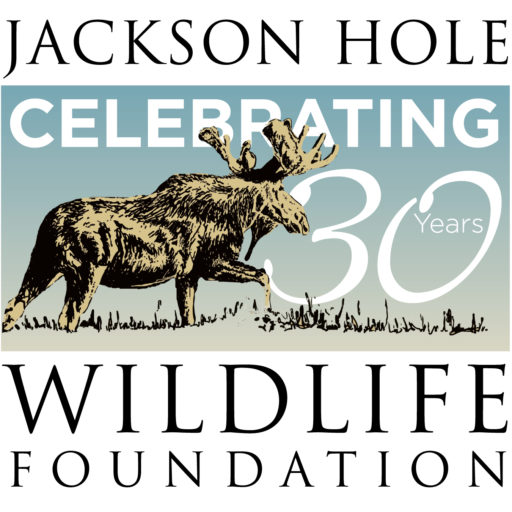
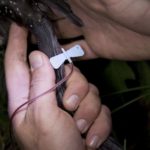
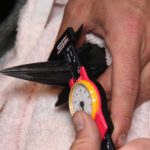
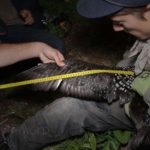
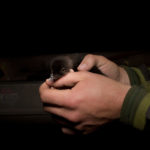
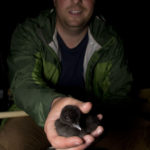
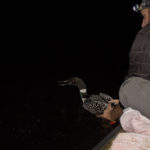

 Very recently an exclusive opportunity was made available to all certified Nature Mappers and 13 of them joined JHWF and scientist Anya Tyson on July 25 for a discussion on the Clark’s Nutcracker — a clever bird with a big conservation importance.
Very recently an exclusive opportunity was made available to all certified Nature Mappers and 13 of them joined JHWF and scientist Anya Tyson on July 25 for a discussion on the Clark’s Nutcracker — a clever bird with a big conservation importance.


 Over the past several weeks, a unique situation was unfolding along our Mountain Bluebird Nestbox Monitoring Trail here in Jackson Hole. Thanks to a serious winter, flooding occurred in our area from fast melting, high altitude snow. Historic flood levels not witnessed in decades. On a Mountain Bluebird trail of 110 nestboxes, several north of town were underwater for weeks, but fortunately those boxes were empty. However, one box — Box #4 — managed to stay just above the flood waters and it held four baby chicks inside. As the Gros Ventre River continued to flow fast and furiously, these hatchlings grew older and days closer to fledging their nest. This posed a great conundrum for the staff of JHWF… .
Over the past several weeks, a unique situation was unfolding along our Mountain Bluebird Nestbox Monitoring Trail here in Jackson Hole. Thanks to a serious winter, flooding occurred in our area from fast melting, high altitude snow. Historic flood levels not witnessed in decades. On a Mountain Bluebird trail of 110 nestboxes, several north of town were underwater for weeks, but fortunately those boxes were empty. However, one box — Box #4 — managed to stay just above the flood waters and it held four baby chicks inside. As the Gros Ventre River continued to flow fast and furiously, these hatchlings grew older and days closer to fledging their nest. This posed a great conundrum for the staff of JHWF… .




 Last month, JHWF’s Executive and Associate Directors attended the biannual meeting of the
Last month, JHWF’s Executive and Associate Directors attended the biannual meeting of the 